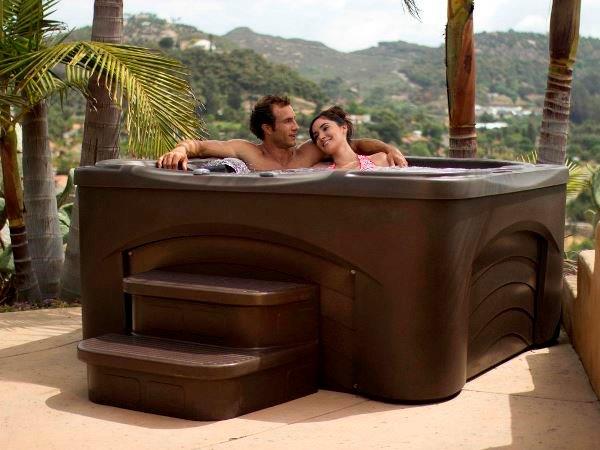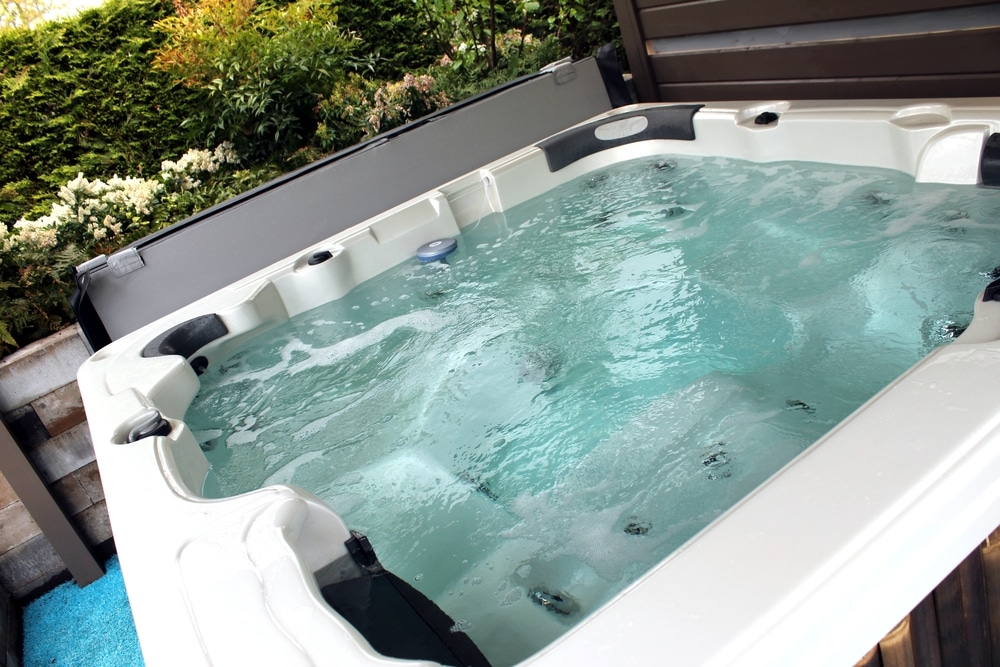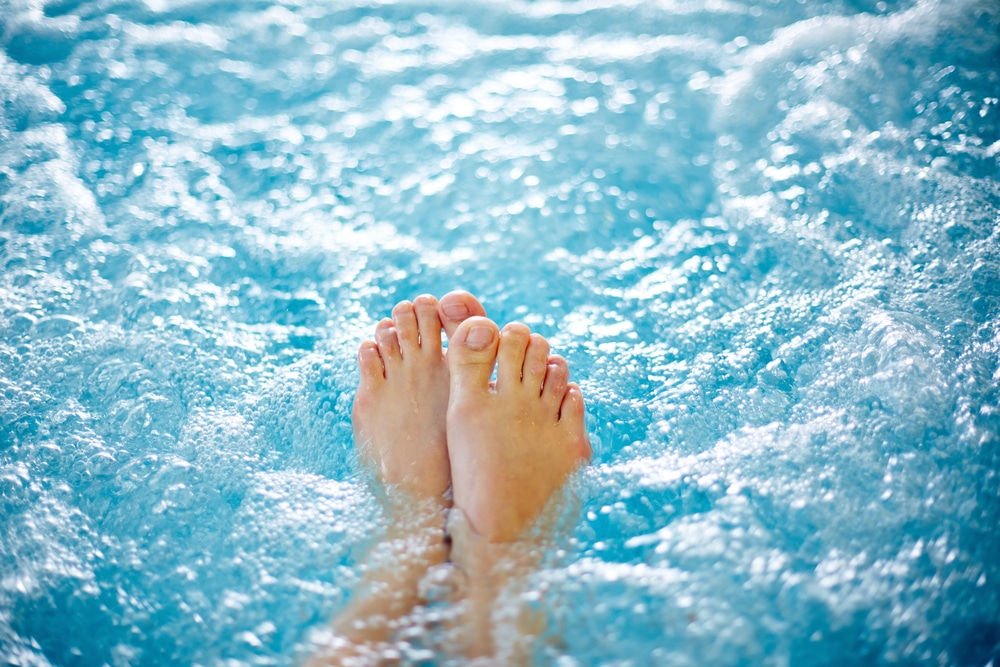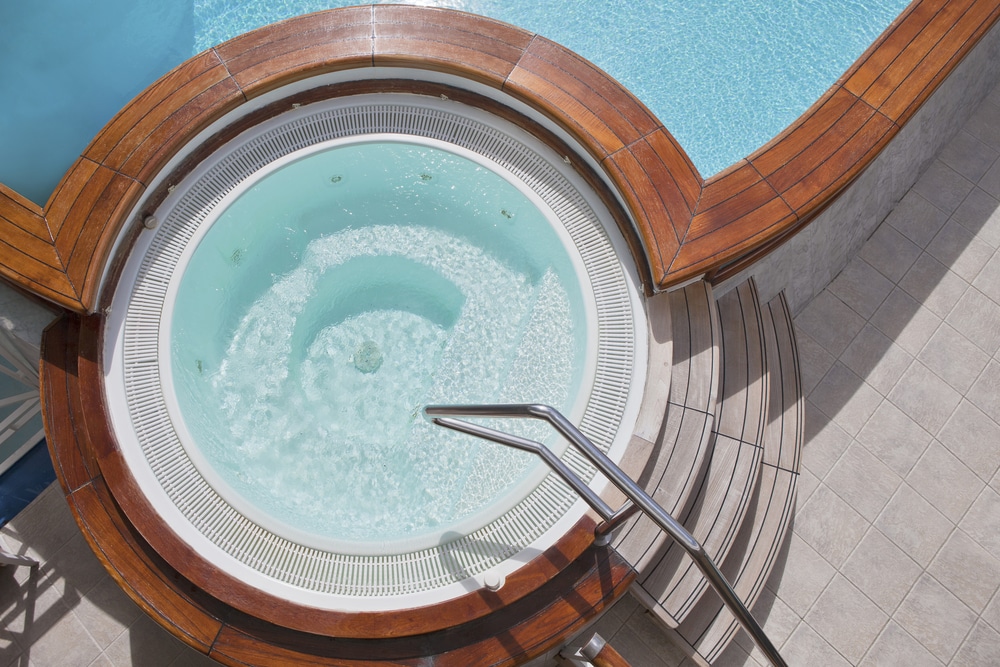Spa Chemistry
Spa (also called “hot tub”) chemistry is quite a bit different than pool chemistry. Spas operate at higher temperatures and hold a much smaller volume of water. The ratio of bathers to water is substantially higher in a spa, meaning a lot more bather-introduced wastes (sweat, hair, cosmetics, body lotions, etc. etc.) are found in hot tubs. Spas must be monitored and maintained differently than pools.
The higher temperatures will cause faster chemical reactions and decay, increased scale formation, more organic waste in the water, and accelerated bacteria growth. Heavier bather loads and lower water volume require more precise chemical dosages, and much higher filtration (water turnover) rates. Sanitizer residual depletes far more rapidly and more abrupt changes in pH take place in a hot tub.
Balancing the hot tub, ensuring that mineral and chemical levels remain within acceptable ranges, is the key to maintaining your investment and bather comfort in the spa. In extreme cases, failure to maintain these levels can result in skin reactions like rashes, that can limit your ability to enjoy your hot tub.

High Temperatures
A pool usually operates between 20C and 30C, while spas are typically run at a much higher temperature, between 37C to 40C. This difference in temperature will change the water chemistry in several important ways.
Chemical reactions in hot tubs occur much faster than in pools. For every 8 degrees Celsius increase, the chemical reaction time is twice as fast. For example, chemical reactions in a hot tub heated to 38.8 C occur in half the time of a pool heated to 28.8 C. Any chemical adjustment can happen more quickly, so for example, it takes less time for the pH to rise (often a by-product of adding shock). The water comes to equilibrium sooner, and water treatment can be completed in a shorter period of time. At higher temperatures, sanitizer is used up faster as well.
The water in a hot tub also evaporates at a higher rate due to high water temperature, rapid water circulation and aeration. As water evaporates, the spa owner adds water to replenish the system. Any water that evaporates is pure; that is how distilled water is made. In a hot tub, the water evaporates and leaves behind everything else. The residue of minerals and other materials we call total dissolved solids (TDS).
Fresh water also contains some minerals, salts and other elements that increase the TDS. Depending on the source, it can increase a little (city water) or a lot (most well water), so adding fresh water can add to the TDS as well. High levels of TDS decrease the effectiveness of some chemicals and can contribute to cloudy water. Generally, when TDS rises beyond 2000 – 2500 PPM the spa water becomes very hard to manage, thus we recommend draining and refilling. TDS is a test we perform at no charge in our store, and we recommend you visit every 6 weeks to monitor.

Higher temperatures in spa water will cause most chemicals to dissolve faster than in lower temperatures, except for calcium. This form of hardness is actually more insoluble in hot water. Therefore, calcium carbonate scale is more likely to occur in hot spa water.
The hot water in spas also makes people sweat, though in water they rarely notice it happening. The average bather will perspire almost 1/2 litre in just 20 minutes. In addition, the jets in a hot tub will slough off dirt and dead skin very quickly. All of this means that the filter and chemical sanitizer in a spa have to process a lot of waste. Consequently, paying close attention to the sanitizer lever is critical in a spa, between the higher temperature and higher waste introduction, going from plenty of sanitizer to not enough sanitizer can happen in a few minutes. You need to check sanitizer regularly, and it is not uncommon to need to add some every time you use the spa; many hot tub owners will add immediately before or immediately after each use.
Without adequate sanitizer, a hot tub creates a perfect incubator for bacteria. Hot water promotes the growth of most types of bacteria.
Smaller Volume
Hot tubs contain a much smaller volume of water than pools. This leads to other differences that may not be obvious. The bather load is heavier for spas because of its much smaller size. A common load in a hot tub would have one person in 350 L to 1800L of water. Pools tend to have at least 10 times that amount of water for every swimmer. Consider this: Two bathers in a 1500 L (typical home size) spa are roughly equivalent to 135 people in a 100,000 L (typical home size) swimming pool.
This significant bather load can decrease the sanitizer levels very quickly. Chemicals need to be measured precisely and the water needs to be tested at a minimum weekly by the homeowner. Misjudging the required dosage can drastically alter the chemistry in a small volume of water, resulting in too little sanitizer (which poses a health risk) or too much sanitizer (which damages equipment). For this reason there are chemicals specifically designed and labelled for treating spas. These lower the risk of adding too much or not enough of a particular chemical or mineral. For example, MPS (a type of non-chlorine shock) for hot tubs is a very different formulation than MPS for swimming pools.
Spas use up the sanitizer very quickly, which is why a higher level of sanitizer needs to be maintained in spa water than in pools. Industry standards reflect this fact, requiring sanitizer levels to be higher in hot tubs, as do municipal by-laws governing public and commercial facilities. Health Canada recommends a sanitizer level of 3 to 5 ppm in your hot tub at all times.

A hot tub’s lower water volume means that even small additions of sanitizers and other chemicals can have an immediate effect on the pH of the water. If the wrong amount of a chemical or a mineral is added to a pool, there’s a little time before the chemical/mineral circulates throughout the entire system. In the case of a spa, that reaction time is lost completely. To avoid equipment damage, the sanitizer should be measured carefully and the pH tested frequently
Mineral Balancing
Along with ensuring a safe level of sanitizer you will need to add minerals to adjust the balance of your hot tub. The correct levels of pH, Alkalinity, Calcium, and Borate will make your tub easier to care for, more comfortable to use, and protect your investment. Almost all hot tub manufacturers require that you maintain proper water balance to maintain your warrantee, and specifically exclude damage caused by improper water balance from their coverage. This tells you how important it is to manage water balance. Balancing the water means that chemicals such as sanitizers can function properly; water that is out of balance (for example, a high pH) can slow down the efficiency and effectiveness of sanitizer, such that you can be reading a safe level of chlorine on your test strips, but in reality because of the mineral imbalance the chlorine is unable to kill bacteria properly.
pH in a hot tub should range between 7.2 and 7.6. If the pH is lower than 7.2, the water becomes more corrosive, attacking pillows, covers, heater elements, and even worse, bathers skin and eyes. Over time a low pH can damage the tub causing costly repairs, and the water becomes very uncomfortable for bathers. Some bathers are affected more than others, but itchy skin, stinging eyes, and nasty smells are common symptoms. It is no great surprise that we are more comfortable in a tub with a pH of 7.5, as that is the same pH as our skin and eyes. Another happy coincidence is that both chlorine and bromine work their best between 7.4 and 7.6.
When the pH rises, minerals and metals are more likely to fall out of solution, leaving deposits and stains on the surfaces of your hot tub, inside the plumbing, and inside mechanical equipment such as your heater. As layers of calcium build up on your element, it becomes less efficient, costing you more in electricity to run your tub, and eventually causing the element to overheat and burn out. An element caked in calcium will never be credited with warrantee. In addition the water becomes uncomfortable for bathers, and the risk of developing hot tub rash increases due to the ineffectiveness of the sanitizer. Often hot tub users are convinced that they are allergic to chlorine or bromine when in fact, the rash is caused by a high pH and low or ineffective sanitizer.
Alkalinity is important because when maintained at 100 to 140ppm, it helps prevent pH bouncing up and down with every chemical addition. Think of Alkalinity as a stool that pH sits on; when Alkalinity is at the correct level, it holds pH between 7.2 and 7.6. When Alkalinity is low, the pH drops with it and the water becomes corrosive. When Alkalinity is high, the pH climbs with it, and the water becomes scale forming. Alkalinity does change with use of the hot tub, so you should keep track of it with your test strips. Remember, if you set your Alkalinity you can stop chasing pH.
Calcium is often the “unpopular kid” of water balancing and doesn’t get invited to the party. This is one mineral that you don’t want to leave out, just be sure to manage it so you achieve the correct level. When your water has a calcium level of less than 150ppm, the water seeks calcium wherever it can, and will attempt to pull it out of the spa surface, metal components, and most obviously on soft spa pillows, causing bubbles and peeling. If combined with a low pH, low calcium can cause serious corrosion and etching of the heater and metal fixtures, such as the stainless steel trim often found in modern hot tubs. It also can seriously shorten the life span of cartridge filters. Filling your hot tub from a municipal supply or through a softener is not a bad thing, simply be aware that you will need to add some calcium because these are typically very soft (low calcium) sources.
When the calcium level is too high in your hot tub, this often comes from very hard source water. It can also come from adding too much calcium to the spa, or the regular use of calcium based chlorine formulations. When high calcium and high pH combine, scale formation on all surfaces happens very quickly. Calcium cannot be removed from the water, you can inhibit scale formation by keeping pH between 7.2 and 7.6 and using Purewater Prevent II to keep it in solution. In some extreme cases, we may recommend having fill water for the spa trucked in to avoid high calcium all together. If you already have scale on the side of your hot tub, drain your tub, and use Purewater Prevent II directly on the surface to remove the built up scale. New hot tub owners, particularly those with well-source water, are encouraged to have Purewater do a complimentary test on their source water to establish whether calcium is likely to be an ongoing concern.
Borates are the feel good mineral in hot tub balancing. Borates are commonly used in eye drops such as Murine or Visene, eyewash solution, and contact lens solutions because they feel soothing to our skin/eyes. The added benefit in spas is that Borates make the sanitizer more effective so you can use less. Purewater Ultra Spa adds Borates to your tub without changing pH, and it has a lovely scent too!

Enzymes are a relatively new technology featured in the Spa Perfect line. Enzymes digest and break down oils and greases, which has several significant benefits. Less oil and grease means your sanitizer is freed up to work on bacteria, so you can use less chlorine. It dramatically extends the life of filter cartridges and lengthens the time between filter cleanings. Finally, it makes a big difference in dealing with the “bathtub ring” effect. Weekly treatments help keep your spa in tip top shape.
Organic Enhancers are also a relatively new product that help to cut chemical demand. The Spa Serum line works in a similar manner to enzymes, but specifically focuses on biofilm, the organic “goo” that can build up in the pipes and plumbing systems of hot tubs. The most noticeable benefits are again cleaner, clearer water, less frequent filter and water changes, reduced odor, and less demand for chemical sanitizer.
One step in chemical maintenance is doing a full purge and clean out of your spa periodically. Water can become stale, and many spa owners become frustrated as time passes and it seems to take more and more work, more and more product / chemical to maintain their spa. Over time it becomes harder to keep the water clear and clean. For this reason we recommend regular water changes (once every 3 to 4 months typically, depending on bather load); at some point it’s just no longer worth the extra effort to keep managing your old, stale spa water; start fresh! When you drain your spa, we recommend regular (every second water change) the use of a line flush or purge product. Added a couple of hours before you empty the spa, it helps break down any of the scale or build up on surfaces, both those you can see and those you can’t.
Mechanical filtration and circulation are also keys to spa happiness. Often chemicals get the blame for poor water quality or difficulty maintaining the spa. Bear in mind that if water does not pass through the filters often enough, more and more work falls to your chemical sanitizer. In other words, you need more and more chemical to do the job that your filters should be doing. Keeping filters clean is as simple as periodically giving them a good rinse (once every 2 to 3 weeks depending on bather load), and every 2 or 3 times you would rinse them, giving them a deep clean. Deep cleaning is most often an overnight soak in a solution that removes scale and organic buildup, leaving the filters free and clear to properly do their job. We strongly recommend having 2 sets of filters, meaning you always have a back up set when its time to do a deep cleaning. Another benefit is you can allow your freshly cleaned filters to dry after cleaning; as they dry, the fibers in the filter constrict, making them much more efficient when they go back into your spa. Finally, be aware of different types of filters. Pleated Reemay filters, a coated thin fiber like paper, can be cleaned and reused multiple times. Deep filters or micron filters are designed to absorb oils and greases deep into their cell structure, making them more efficient filters but also requiring replacement and disposal; you cannot clean a micron filter.














